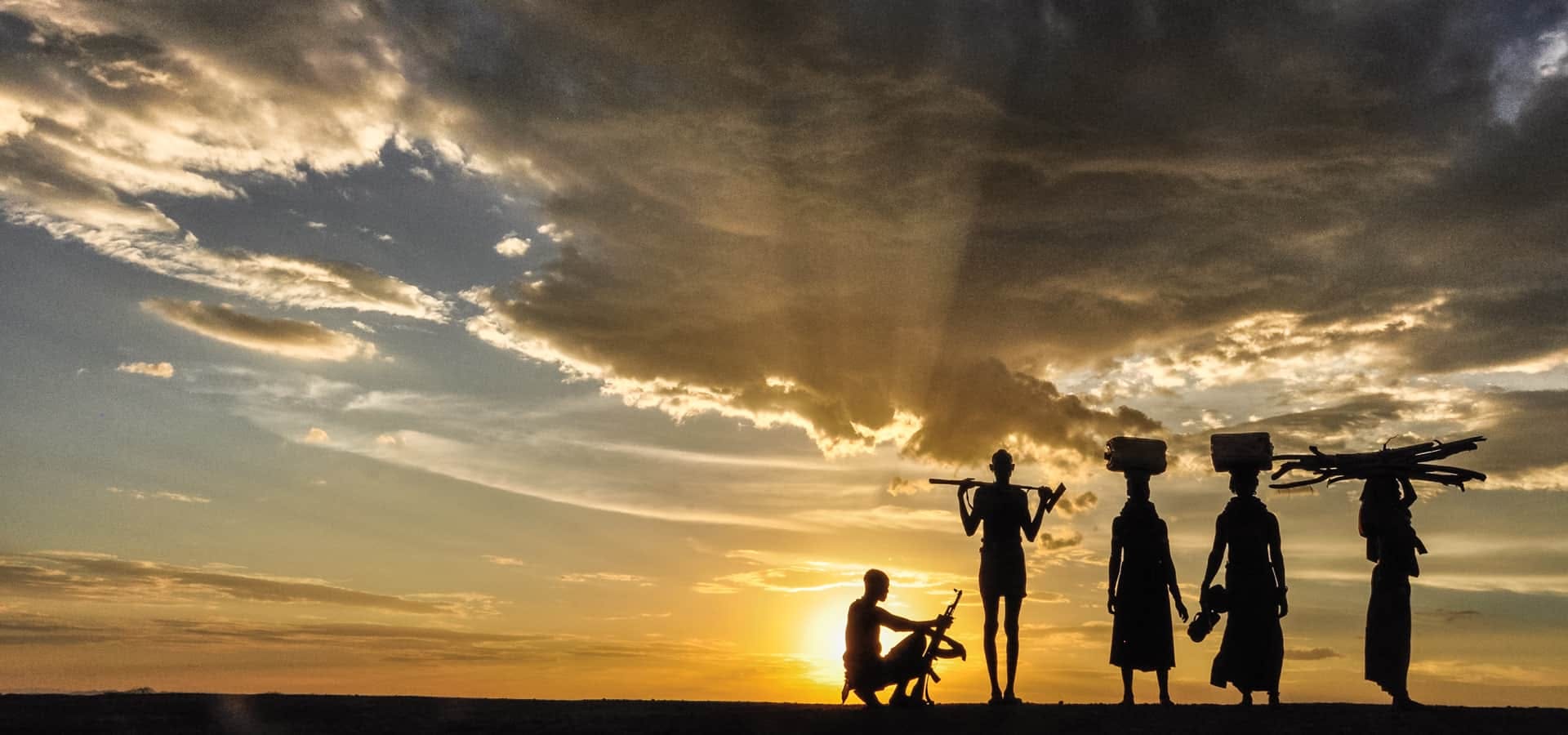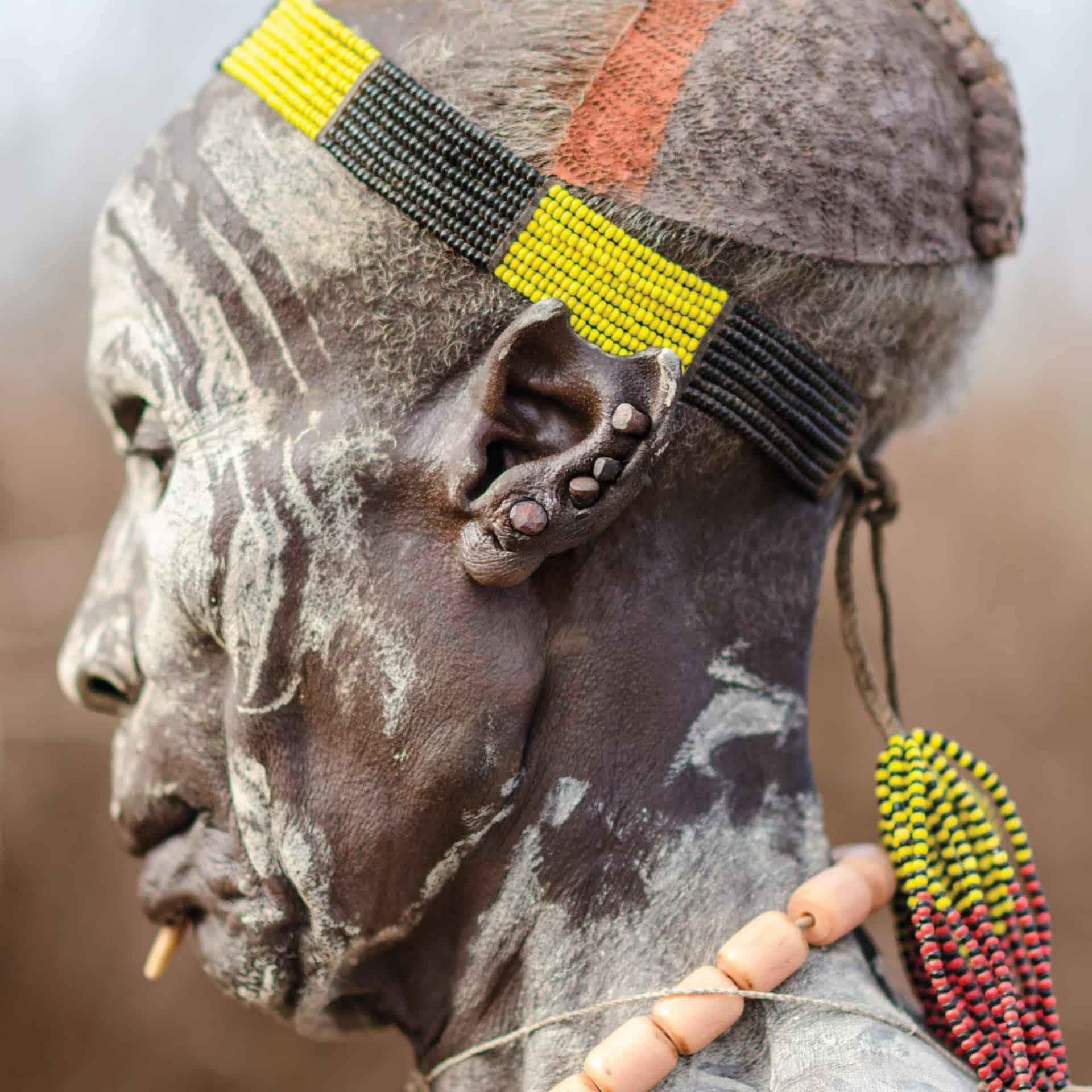
With her vehicle bogged down once again—a frequent occurrence in the rugged terrain of Africa’s remote Omo Valley—Lynn Doran discovered what all photojournalists soon learn: A good pair of shoes is more important than the best of cameras or lenses.
So how did a nice local girl end up in a faraway corner of Ethiopa … dubbed “Africa’s last frontier” by National Geographic? In a one-thing-leads-to-another way, it’s kinda/sorta the result of a love of skiing.
A native Californian who attended Palos Verdes High School, the University of Colorado and California State University, Lynn graduated college with a B.A. in fine art. “When I graduated from art school, I’d never had a job,” she explains. “Instead I went to Aspen to ski. Then I discovered living in Aspen required income!”
Unabashed and ever resourceful, Lynn shifted into creative gear and asked her mother to immediately send her sewing machine. She began custom- designing apparel including chic leather pants and other garments, which proved immediately popular.
She chose the brand name Natty for her company, which became a successful national design and manufacturing business of women’s specialized ski accessories and contemporary tennis and golf attire. After proving herself in business, Lynn longed to get back into art and began exploring new ways of expanding her artistic horizons.
“[The year] 2000 was a turning point in my life,” she recalls.
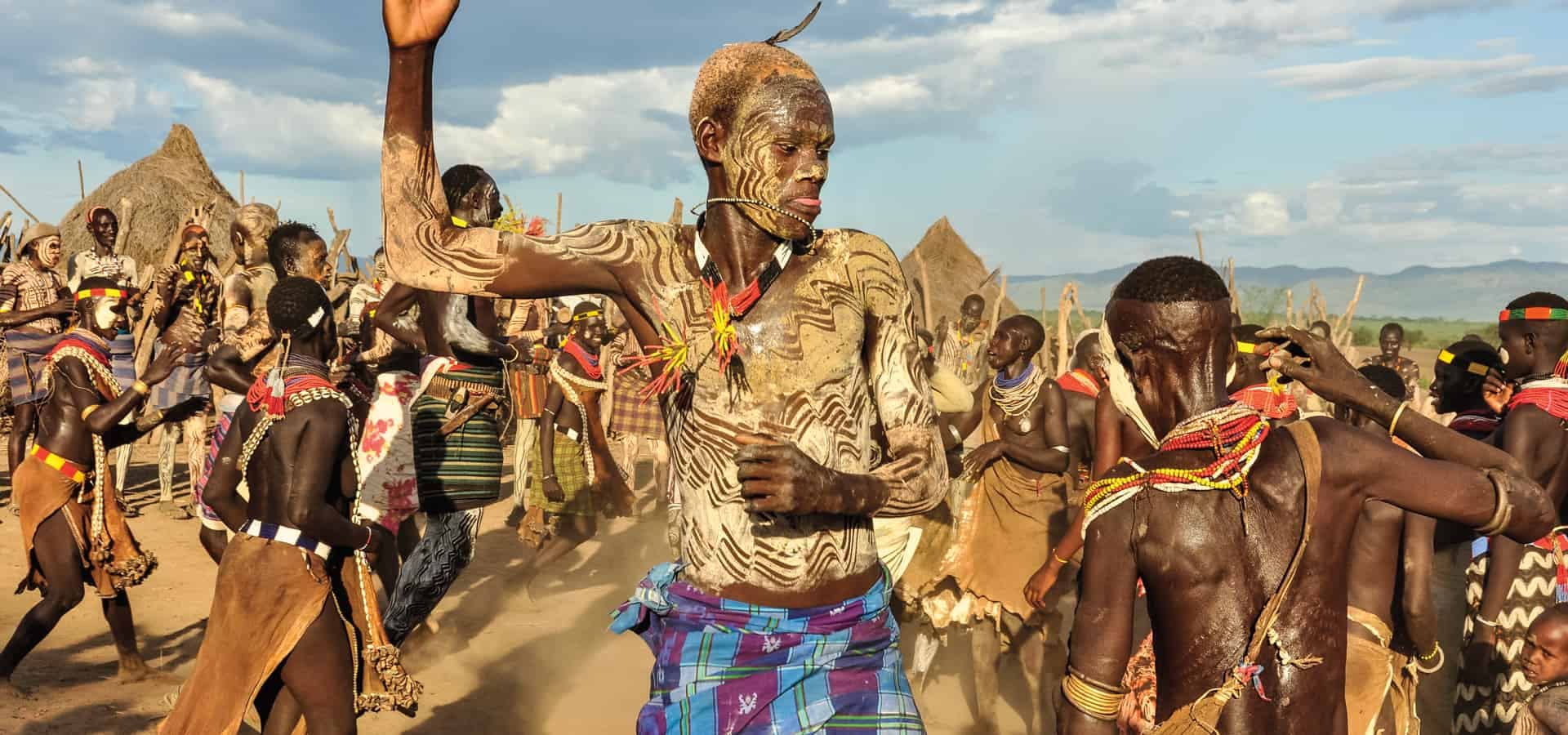
TRIBAL LIFE
Life for the Omo tribes may be bucolic, but it’s not always peaceful. Their economy centers around cattle raising, and the cattle must be protected from both man and nature. Many of the men casually carried a Kalashnikov automatic rifle—necessary as protection against ever-present cattle thieves.
Some of the rituals that Lynn observed were also very dangerous. During one of the frequent village “stick fighting” contests, the competition proved fatal.
“Near our camp we could hear the activity—yelling, shouting, cheering,” Lynn explains. “Suddenly it changed, and we heard screaming and wailing. A blow from a stick across one man’s chest caused his death. In the excitement, automatic weapons were fired. A bullet struck another man. We did not hear if he survived.”
What has survived is Lynn Doran’s successful photographic documentation. We leave her images feeling we’ve gotten to know these people and their culture—thankfully preserved for posterity in the pages of Omo.
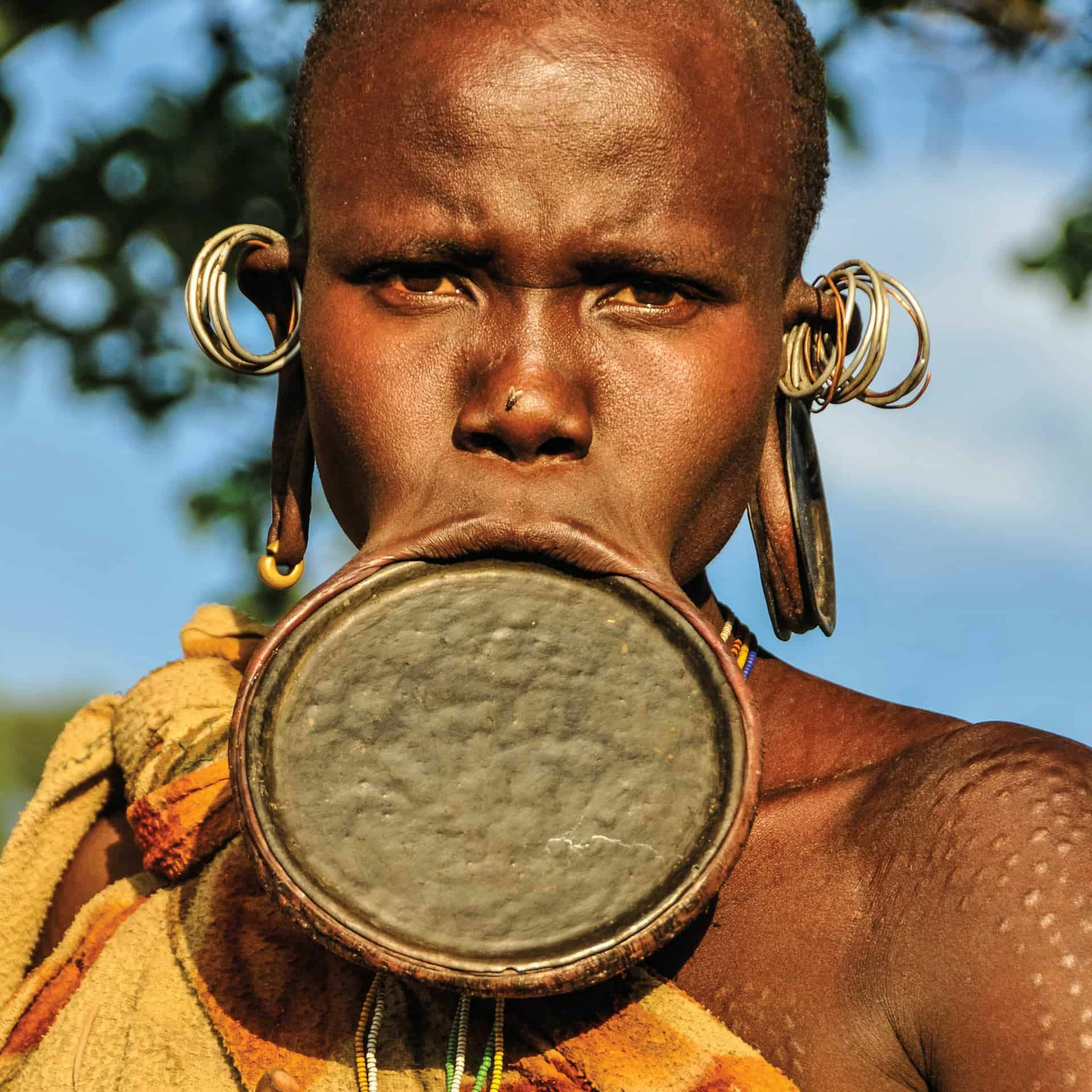
DRESSING UP
As Lynn’s images illustrate, Omo Valley’s tribes have rich traditions of body adornment—their form of “dressing up” for a variety of cultural events. Their semi-nomadic life is enhanced by extensive celebrations of marriage, childbirth and other rites of passage such as “bull jumping,” where young men exhibit physical skills that enhance their social position as warriors … and attract girls.
Though cow dung, chalk and charcoal would be anathema on a Western woman’s dressing table, they are the organic staples of personal adornment for both men and women—along with elaborate body scarring and a wide array of jewelry artfully fashioned from spent AK-47 shell-casings.
The images in Omo show vividly alive, graphically decorated and painted figures. Some of the women wore lower-lip “plates,” and some of the men were adorned with wooden “pillows” that preserved the shape of their elaborately coifed hair.
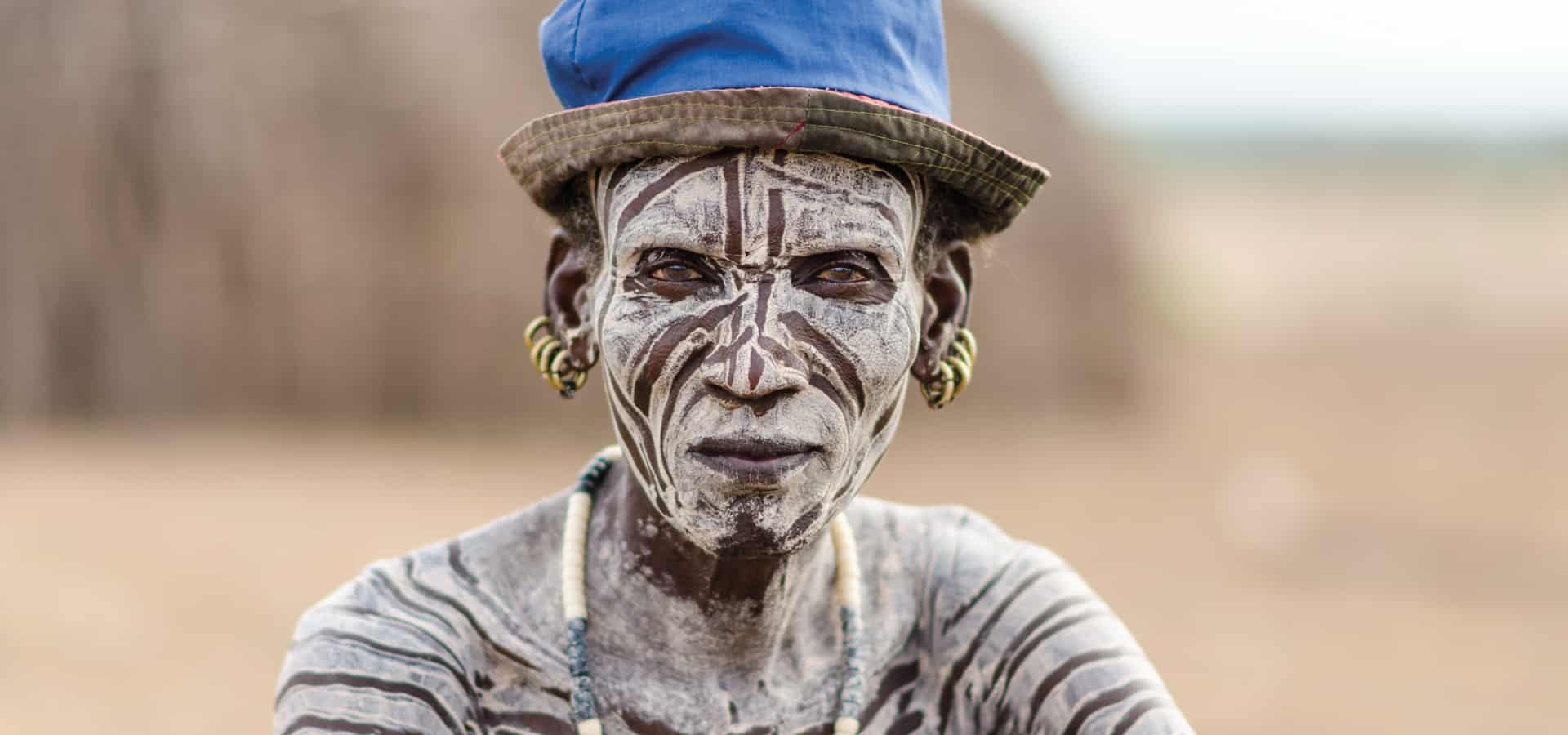
A PLENTIFUL ADVENTURE
In addition to art and photography, Lynn has also had a passion for travel for as long as she can remember. Success in her business allowed her to combine those passions, and she started traveling the world—photographically documenting what she experienced.
She had traveled to Africa previously, and at some point she caught a glimpse of photos depicting tribespeople from the Omo Valley in Ethiopia. She knew she had to see this place—one of the world’s last extensive tribal lands. So she began a three-year planning process.
Meanwhile she learned that the Gilgel Gibe III Dam was to be constructed soon on the Omo River—likely endangering the existence of these indigenous tribes and their culture. She knew it would most certainly alter tribal life in the region, bringing with it new development, people, hotels and tourism. And Lynn wanted to experience life with the tribes of the Omo Valley before that happened.
So in 2013 she ventured to the remote Omo Valley with a group of seven and their Kenyan guide. Her art background served her well during this three-week journey into the “last frontier.” Relying on her artistic sense of color and composition, which—unlike her heavy Nikon camera body and trusty EF 70-200, f2 lens—weigh nothing but would determine everything, she took nearly 4,000 photos of several tribes of people.
Lynn eventually published some of those images in her photographic documentary book, Omo, released in 2016. It conveys the essence of what she saw and experienced on her African adventure.
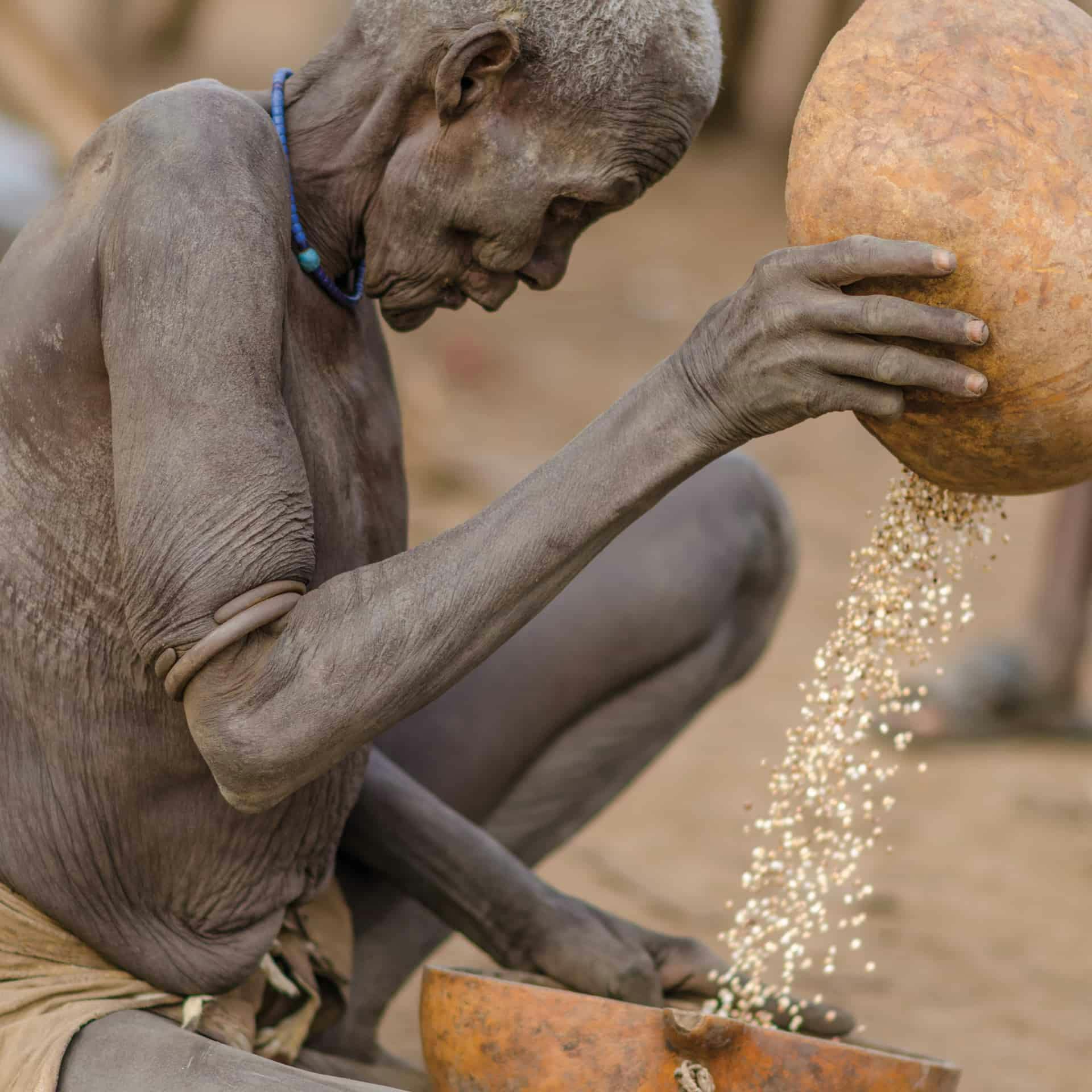
ARTIST MEETS CAMERA
Visual by nature, Lynn developed an interest in photography. “I knew nothing about things like aperture, ISO, f-stops, shutter speed—let alone the technology that is so important with digital photography. I’d only used a point-and-shoot,” she shares.
So she signed up for a five-week photo workshop led by acclaimed National Geographic photographer Joe McNally. “After our first outdoor shoot, Joe sat down next to me and said, ‘Show me the metadata.’ ‘Metadata?’ I thought, ‘What was he talking about?’” Lynn says, shaking her head.
Teaching digital technology was only one part of Joe’s approach. The rest was strictly physical. “Move your feet, peel the onion and remember: Your best shot may be behind you,” he instructed, emphasizing constant 360º observation. It was advice that would pay off in Africa.
Lynn is an artist first … a photographer next. Good photography requires the ability to disregard conventional ways of looking at things in order to seek the elusive combination of composition and timing. The result is artistically expressive images that separate the ordinary iPhone snapshot from a photograph selected for a gallery or museum wall. And that precisely describes Lynn’s photographic art.
As the acclaimed French photographer Henri Cartier-Bresson so concisely put it: “To take photographs means to recognize—simultaneously and within a fraction of a second—both the fact itself and the rigorous organization of visually perceived forms that give it meaning.”
In both her cliffside Palos Verdes, California home and murs-blancs San Pedro studio, artist Lynn Doran fills space with indigenous Mexican and African art, pieces of her own imaginative and often humorous ceramics, sculpture, assemblages, textiles, weavings and selected photographic prints. A quick glance reveals that her talent takes many forms—most recently with the 2016 publication of Omo, her literary debut. Through written and photographic storytelling, Lynn takes readers deep into the African continent—unveiling a secluded tribal culture that’s nearly on the verge of extinction.
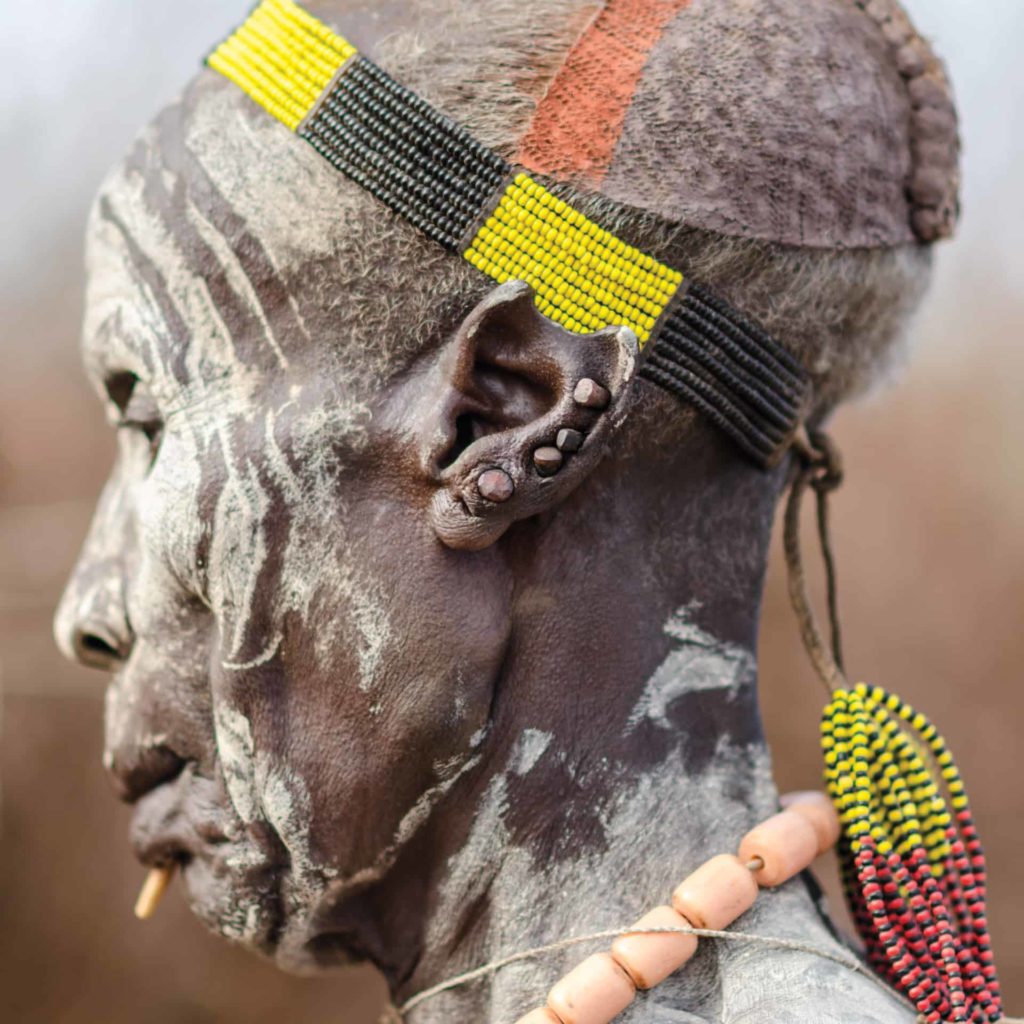
With her vehicle bogged down once again—a frequent occurrence in the rugged terrain of Africa’s remote Omo Valley—Lynn Doran discovered what all photojournalists soon learn: A good pair of shoes is more important than the best of cameras or lenses.
So how did a nice local girl end up in a faraway corner of Ethiopa … dubbed “Africa’s last frontier” by National Geographic? In a one-thing-leads-to-another way, it’s kinda/sorta the result of a love of skiing.
A native Californian who attended Palos Verdes High School, the University of Colorado and California State University, Lynn graduated college with a B.A. in fine art. “When I graduated from art school, I’d never had a job,” she explains. “Instead I went to Aspen to ski. Then I discovered living in Aspen required income!”
Unabashed and ever resourceful, Lynn shifted into creative gear and asked her mother to immediately send her sewing machine. She began custom- designing apparel including chic leather pants and other garments, which proved immediately popular.
She chose the brand name Natty for her company, which became a successful national design and manufacturing business of women’s specialized ski accessories and contemporary tennis and golf attire. After proving herself in business, Lynn longed to get back into art and began exploring new ways of expanding her artistic horizons.
“[The year] 2000 was a turning point in my life,” she recalls.

Tribal Life
Life for the Omo tribes may be bucolic, but it’s not always peaceful. Their economy centers around cattle raising, and the cattle must be protected from both man and nature. Many of the men casually carried a Kalashnikov automatic rifle—necessary as protection against ever-present cattle thieves.
Some of the rituals that Lynn observed were also very dangerous. During one of the frequent village “stick fighting” contests, the competition proved fatal.
“Near our camp we could hear the activity—yelling, shouting, cheering,” Lynn explains. “Suddenly it changed, and we heard screaming and wailing. A blow from a stick across one man’s chest caused his death. In the excitement, automatic weapons were fired. A bullet struck another man. We did not hear if he survived.”
What has survived is Lynn Doran’s successful photographic documentation. We leave her images feeling we’ve gotten to know these people and their culture—thankfully preserved for posterity in the pages of Omo.
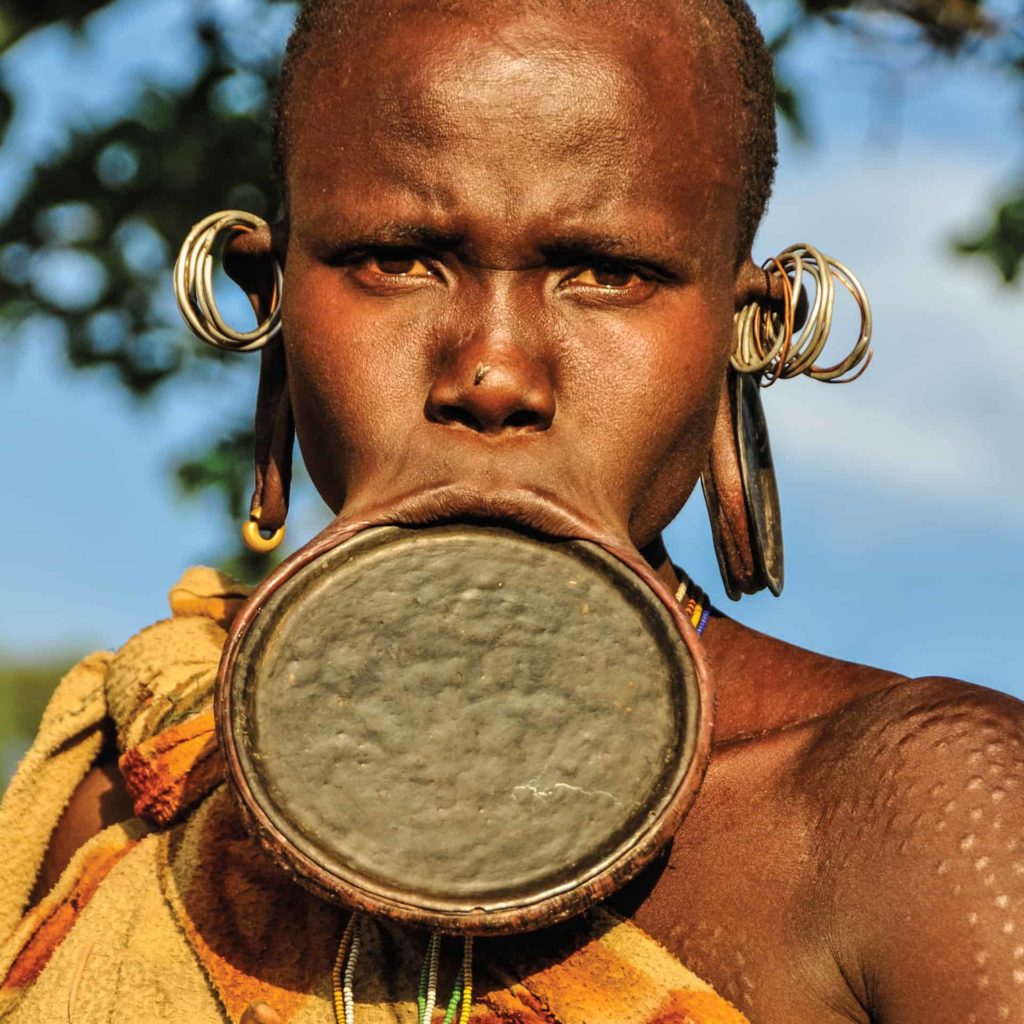
Dressing Up
As Lynn’s images illustrate, Omo Valley’s tribes have rich traditions of body adornment—their form of “dressing up” for a variety of cultural events. Their semi-nomadic life is enhanced by extensive celebrations of marriage, childbirth and other rites of passage such as “bull jumping,” where young men exhibit physical skills that enhance their social position as warriors … and attract girls.
Though cow dung, chalk and charcoal would be anathema on a Western woman’s dressing table, they are the organic staples of personal adornment for both men and women—along with elaborate body scarring and a wide array of jewelry artfully fashioned from spent AK-47 shell-casings.
The images in Omo show vividly alive, graphically decorated and painted figures. Some of the women wore lower-lip “plates,” and some of the men were adorned with wooden “pillows” that preserved the shape of their elaborately coifed hair.
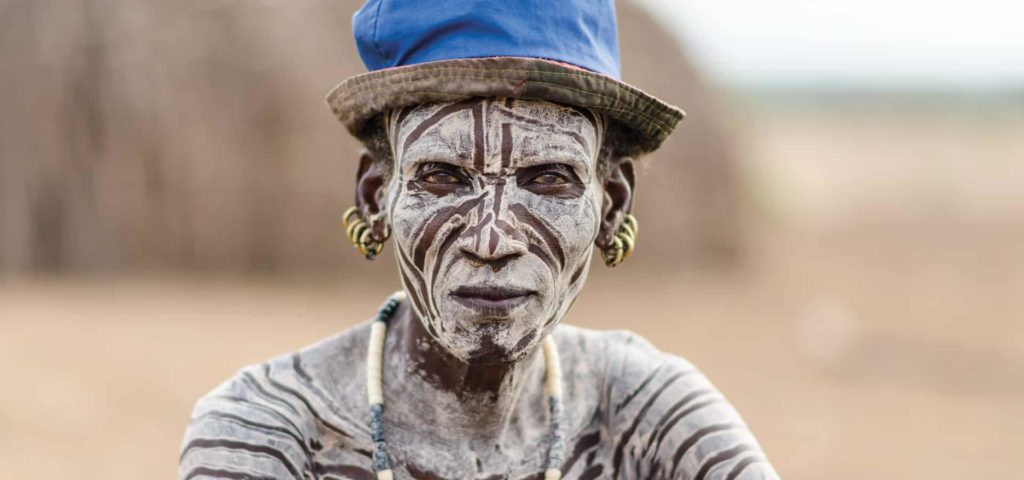
A Plentiful Adventure
In addition to art and photography, Lynn has also had a passion for travel for as long as she can remember. Success in her business allowed her to combine those passions, and she started traveling the world—photographically documenting what she experienced.
She had traveled to Africa previously, and at some point she caught a glimpse of photos depicting tribespeople from the Omo Valley in Ethiopia. She knew she had to see this place—one of the world’s last extensive tribal lands. So she began a three-year planning process.
Meanwhile she learned that the Gilgel Gibe III Dam was to be constructed soon on the Omo River—likely endangering the existence of these indigenous tribes and their culture. She knew it would most certainly alter tribal life in the region, bringing with it new development, people, hotels and tourism. And Lynn wanted to experience life with the tribes of the Omo Valley before that happened.
So in 2013 she ventured to the remote Omo Valley with a group of seven and their Kenyan guide. Her art background served her well during this three-week journey into the “last frontier.” Relying on her artistic sense of color and composition, which—unlike her heavy Nikon camera body and trusty EF 70-200, f2 lens—weigh nothing but would determine everything, she took nearly 4,000 photos of several tribes of people.
Lynn eventually published some of those images in her photographic documentary book, Omo, released in 2016. It conveys the essence of what she saw and experienced on her African adventure.
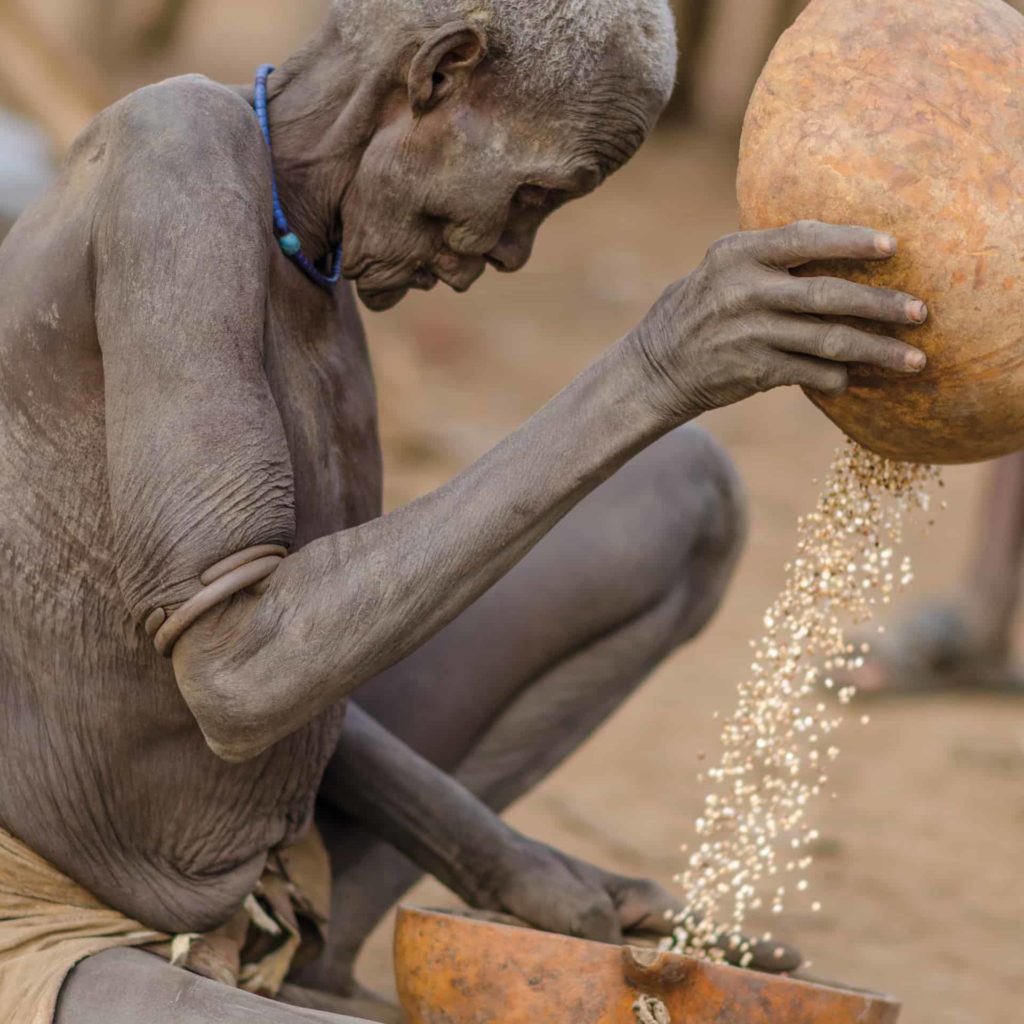
Artist Meets Camera
Visual by nature, Lynn developed an interest in photography. “I knew nothing about things like aperture, ISO, f-stops, shutter speed—let alone the technology that is so important with digital photography. I’d only used a point-and-shoot,” she shares.
So she signed up for a five-week photo workshop led by acclaimed National Geographic photographer Joe McNally. “After our first outdoor shoot, Joe sat down next to me and said, ‘Show me the metadata.’ ‘Metadata?’ I thought, ‘What was he talking about?’” Lynn says, shaking her head.
Teaching digital technology was only one part of Joe’s approach. The rest was strictly physical. “Move your feet, peel the onion and remember: Your best shot may be behind you,” he instructed, emphasizing constant 360º observation. It was advice that would pay off in Africa.
Lynn is an artist first … a photographer next. Good photography requires the ability to disregard conventional ways of looking at things in order to seek the elusive combination of composition and timing. The result is artistically expressive images that separate the ordinary iPhone snapshot from a photograph selected for a gallery or museum wall. And that precisely describes Lynn’s photographic art.
As the acclaimed French photographer Henri Cartier-Bresson so concisely put it: “To take photographs means to recognize—simultaneously and within a fraction of a second—both the fact itself and the rigorous organization of visually perceived forms that give it meaning.”




